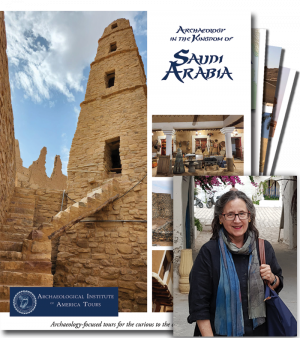Join archaeologist Barbara A. Porter and a small group of fellow travelers for this in-depth travel experience in Saudi Arabia. This will be Dr. Porter’s fourth tour of the country, and you will also be accompanied by local guides and a tour manager.
This tour opportunity allows us to see, experience, and learn about Saudi Arabia’s long history and rich culture, and how both were influenced by its dramatic geography; and to become familiar with some of the archaeological research and sites that are being uncovered and shared with the world. Following historic trade and pilgrimage routes, we will cross vast deserts, see irrigated lands teeming with agriculture, and enjoy scenic views with striking mountains and landscapes along the way.
Highlights:
- Visit four of the country’s six UNESCO World Heritage Sites, including the spectacular petroglyphs at Jubbah; the stunning, carved stone, Nabataean tombs at Hegra (Madain Saleh); Al Balad, the historic center of the city of Jeddah; and the Al Turaif District of Diriyah, whose restored citadel and palaces are now an open-air museum.
- Marvel at the 6,000-year-old Rajajil Standing Stones; the Sakaka Rock Carvings, which were just discovered in 2018; and the necropolis of Mughair Shuwayb at Madyan, which was built into the hillside by the ancient Nabataeans.
- Wander the alleys and streets of Ushaiger Heritage Village, with Ushaiger itself being one of the oldest settlements in the region and often considered Saudi Arabia’s most beautiful village.
- Stroll through Al Ula’s Old Town, whose town walls encircle some 900 mudbrick homes, 400 shops, a restored Friday Mosque, and the 10th-century Musa bin Nusayr Castle.
- Experience the holy city of Medina, a major Islamic pilgrimage site; and marvel at the capital city of Riyadh, which transformed from a mud-walled town to a metropolis of 7+ million people in the span of a century.
- Explore bustling markets such as the Unayzah Market; Buraydah’s camel market, perhaps the largest camel market in the world; and Riyadh’s Dira Souq, where we learn about traditional Saudi clothing.
Tour Prices (15 nights)
Per person, double occupancy
12-16 participants $12,595
10-11 participants $13,095
Single Supplement (limited availability) $2,695
A single supplement will be charged when requested or required. With fewer than 10 participants, a small group surcharge may be added.
Download the detailed brochure.
For advance information or questions, please email us at aia@studytours.org (and include your full name) or call us toll-free at (800) 748-6262 (toll: 603-756-2884). To reserve your space using the online form, click here
